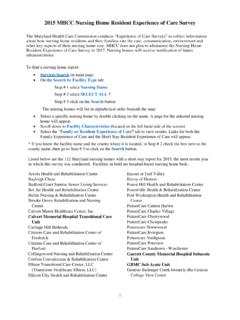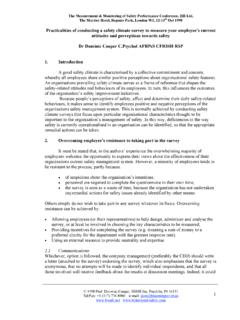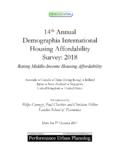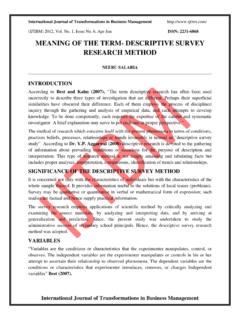Transcription of 338-2011: An Introduction to Survival Analysis …
1 SAS Global Forum 2011 Statistics and Data Analysis Paper 338-2011. An Overview of Survival Analysis using Complex Sample Data Patricia A. Berglund, Institute For Social Research-University of Michigan, Ann Arbor, Michigan ABSTRACT. This paper presents practical guidance on conducting Survival Analysis using data derived from a complex sample survey . Survival curves, Cox models, and discrete-time logistic regression are demonstrated through use of PROC. LIFETEST, PROC SGPLOT, PROC SURVEYPHREG and PROC SURVEYLOGISTIC. The analytic techniques presented can be used on any operating system and are intended for an intermediate level audience. Introduction . The primary objective of this paper is to provide guidance for the analyst performing Survival Analysis using SAS . with complex sample data. A short overview of Survival Analysis including theoretical background on time to event techniques is presented along with an Introduction to Analysis of complex sample data.
2 These introductory sections are followed by a typical analytic progression of descriptive and inferential Survival analyses using appropriate SAS survey procedures. The Analysis examples include Survival curves using the Kaplan-Meier method and regression models predicting onset of the event of interest using common covariates such as age at interview, race/ethnicity and gender. Cox Proportional Hazards and discrete-time logistic regression models are demonstrated and contrasted. The descriptive examples focus on the use of PROC LIFETEST with ODS graphics to produce Survival plots as well as plot generation using PROC SGPLOT with an output data set from the LIFETEST procedure. The modeling examples demonstrate the use of PROC SURVEYPHREG and PROC SURVEYLOGISTIC with selected options such as reference category specification, estimate and class statements, and model link options.
3 Where possible, the Analysis examples include use of the survey design variables and weights to correctly account for the complex sample design. OVERVIEW OF Survival Analysis . EVENT HISTORY DATA. Event history data is common in many disciplines and at its core, is focused on time. Analysis of event history data or Survival Analysis is used to refer to a statistical Analysis of the time at which the event of interest occurs (Kalbfleisch and Prentice, 2002 and Allison, 1995). Event history data can be categorized into broad categories: 1. longitudinal data, 2. administrative follow-up data, and 3. retrospective event history data. Longitudinal data is prospectively collected on individuals followed over time. One example is the Panel Study for Income Dynamics, an ongoing US panel study focused on income dynamics and related topics ( ). Administrative follow-up data comes from a study that collects administrative records and additional survey data for a sample of respondents and then prospectively follows those individuals to a key event such as death by linking to another data source.
4 An example of this type of data might be a medical claims data set that is linked to a mortality data set using respondent Social Security Numbers. The linked files would provide an opportunity to study time to death using a Survival Analysis approach. An example of this type data is the NHANES III linked mortality file ( ). The third category is retrospective event history data where respondents are asked to recall details about an event of interest which occurred at some point in the past. An example of this type of data is the National Comorbidity survey - Replication survey ( ) which contains retrospective data on mental illness and related physical conditions. FEATURES OF Survival Analysis . Survival Analysis centers on Analysis of time to an event of interest, denoted as (T), given the event occurred, or time to censoring, denoted as (C). If an individual is right censored, the respondent does not experience the event of interest before follow-up ends and it is unknown if the event occurs after censoring.
5 Left censoring means that follow- up began after the beginning of data collection. See Figure 1 for a graphic presentation of the common types of timelines. Time and censoring are key pieces of information used in statistical Analysis of event history data. 1. SAS Global Forum 2011 Statistics and Data Analysis Prospective Follow-up of survey Participants End of survey Observation Period Event Beginning of survey Observation Period Nonresponse (Censored). Study Ends (Censored). Begin Obs Study Ends (Censored) (Censored). (From Applied survey Data Analysis , p. 306). Figure 1. Prospective View of Event History survey Data Time can be regarded as continuous or discrete and this basic distinction affects the analytic approach selected. For example, an Analysis of the time in milliseconds to the event of interest ( particle explosion) would be handled using a continuous time assumption while an Analysis of age of onset of alcohol abuse measured in 2 year increments is a discrete time approach since age is measured in coarse time units.
6 DEFINITIONS. Key definitions used in Survival Analysis are presented in this section. Probability density functions, cumulative distribution functions and the hazard function are central to the analytic techniques presented in this paper. For statistical details, please refer to the SAS/STAT Introduction to Survival Analysis Procedures or a general text on Survival Analysis (Hosmer et al., 2008). The probability density function for the event time is denoted by f(t), and is defined as the probability of the event at time t (for continuous time), or by m , denoting the probability of failure in the interval (m, m + 1) for discrete time. The corresponding cumulative density functions are defined in the standard fashion: t F (t ) f (t )dt for continuous t; or 0. m F(m)= (k ) for t measured in discrete intervals of time. k m The CDFs for Survival time measure the probability that the event occurs at or before time t (continuous) or before the close of time period m (for discrete time).
7 2. SAS Global Forum 2011 Statistics and Data Analysis The survivor function or survivorship function, S(t), is the complement to the CDF and is defined as follows: S (t ) 1 P(T t ) 1 F (t ) for continuous time; or S (m) = 1- F (m). The value of the survivor function for an individual is the probability that the event has not yet occurred at time t (continuous) or prior to the close of observation period m (discrete time). The concept of a hazard or hazard function plays an important role in the interpretation of Survival Analysis models. A. hazard is essentially a conditional probability. For continuous time models, the hazard is h(t ) f (t ) / S (t ) or the conditional probability that the event will occur at time t given that it has not occurred prior to time t. In discrete time models, this same conditional probability takes the form h(m) (m) / S (m) (Heeringa, West and Berglund, 2010).
8 Survival Analysis MODELS. Analytic models for Survival Analysis can be categorized into four general types: 1. parametric models 2. nonparametric models, 3. semi-parametric models and 4. discrete time. Analysis examples of all but the parametric model technique are presented in this paper. This is primarily due to the lack of a survey procedure to estimate parametric models in the current version of SAS. Parametric models assume an underlying distribution for the probability function. For example, a common type of parametric model is the exponential distribution. As previously noted, these models are not yet programmed in a SAS survey procedure and thus, are omitted from this presentation. For simple random sample data, however, use of the LIFEREG procedure is appropriate. See the SAS/STAT documentation for details. Nonparametric models include no assumptions regarding the probability density function and use observed data to describe survivor functions and hazards.
9 Although there are limitations to PROC LIFETEST regarding the incorporation of complex sample adjusted variance estimation and integer weights, this procedure still has merit for descriptive Analysis and tests of the proportional hazards assumption. Use of PROC LIFETEST to compute Kaplan- Meier estimates and Survival /failure curves is presented in Example 1. Semi-parametric models do not have strong assumptions about the underlying probability function but do include an assumption of proportional hazards among model covariates. The proportional hazard assumption can be evaluated through examination of Survival curves or by use of model diagnostics where available. Use of PROC. SURVEYPHREG to fit a Cox model with sample survey data is demonstrated and discussed in Example 2. Models such as the logit and complementary log-log are popular choices for discrete time Survival Analysis .
10 Key features of this type of Analysis are a properly structured data set with multiple records per respondent, appropriate model links to define the model, and design corrected variance estimates and hypothesis tests, all available via data step programming and PROC SURVEYLOGISTIC. Use of PROC SURVEYLOGISTIC to fit a discrete time logistic model with complex sample data is presented in Example 3. OVERVIEW OF COMPLEX SAMPLE DATA. The analyst faced with the task of performing Survival Analysis with complex survey data must consider some basic issues and questions. What changes when analyzing complex sample data instead of simple random sample data? What SAS procedures are appropriate for the Analysis at hand? How does SAS incorporate the complex sample information and correctly calculate the statistics? In short, variance estimates and hypothesis tests (and associated degrees of freedom) require incorporation of the design features and probability weights for correct estimation.















